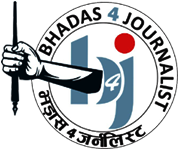‘कारवां’ मैग्जीन में प्रकाशित हुई जागरण मैनेजमेंट के शोषण और मीडियाकर्मियों के संघर्ष की कहानी
हिंदी समाचारपत्र ‘दैनिक जागरण’ प्रबंधन द्वारा संस्थान के मीडिया कर्मियों के शोषण और संघर्ष की कहानी अब आए दिन चर्चाओं में आ रही है। इसी क्रम में मजीठिया वेज बोर्ड की सिफारिशों के अमल को लेकर उसके कर्मचारी विरोधी कदम पर संदीप भूषण ने ताजा सविस्तार टिप्पणी की है। ‘द कारवां’ (The Karavan) मैग्जीन में प्रकाशित पूरी कहानी हम साभार यहां प्रकाशित कर रहे हैं –
How Dainik Jagran’s Employees Have Taken on Their Management Over the Non-Implementation of the Majithia Board Recommendations
It is not often that a journalist has the opportunity to interview a disaffected employee—in this instance, another journalist—who is willing to go on record with complaints against his employers, and does so while he is still on the premises of his workplace. Rarer still is finding more than one member of the workforce willing to make such disclosures. A pragmatic approach would perhaps have prompted more prudence. After all, these are not easy times for journalists.
But, armed with the hope that the Supreme Court will stand by the employees of Dainik Jagran—one of the most widely read Hindi dailies in India—Ratan Bhushan, the fifty-two-year-old deputy news editor of the newspaper has become fearless. Bhushan started his journalistic career at a local Hindi newspaper way back in 1989 on a paltry three-figure salary. Twenty-six years later, he is drawing a little more than Rs 30,000. His annual increment has been a meagre Rs 200 for the last several years. “Management loyalists, sneaks and those doing dirty work for the owners and editors get ten times that amount annually,” he alleged.
Anand Prakash, the publication’s thirty-five year old circulation manager, who joined Jagran’s Noida office ten years ago on a princely salary of Rs 6,500 per month, has not been so lucky. When Prakash joined Jagran in 2005, the total circulation figure of the publication in the Delhi-NCR region was around 22,000. Prakash told me that this figure stands at 4.5 lakhs today. In stark contrast, his salary has increased to only around Rs 12,000—at least Rs 3000 less than the salary of a Class 4 employee at a central university—in the course of the last decade. Voicing his distress at the disparity, he asked, “Don’t I have any contribution towards this growth? Have I also not put my blood and sweat towards this?”
Bhushan and Prakash told me that they are among 350 out of a total of 1500 employees—a figure that was disputed by Nitendra Srivastava, the general manager of Dainik Jagran who told me that there are only 800—from Jagran’s Noida office, both journalists and non-journalists, who slapped contempt proceedings against their organisation in June 2014. The proceedings were initiated before the Supreme Court for non-implementation of the Majithia Board, which was formed to review the remuneration of employees in print publications and was headed by the chairman of National Wage Boards for Working Journalists and other Newspaper Employees, Justice GR Majithia.
The GR Majithia-led Wage Board—the seventh such wage board till date—established under the Working Journalists and Other Newspaper Employees Act 1955, broadly made three relevant recommendations. First, basing itself on the 6th Pay Commission, it categorised newspapers into eight categories with Class 1—the category to which Jagran belongs—being the topmost with annual revenues in excess of Rs 1000 crore. Second, it borrowed the concept of variable pay from the recommendations of the 6th Pay Commission which included a component of an employee’s fixed pay that would typically vary with the employee or the company’s performance, to ensure that the wages of newspaper employees were on par with the employees of other sectors. It suggested that a 35 percent variable pay was to be added to the basic salary, resulting in a corresponding increase in provident fund and gratuity. Finally, it also included a revised rate for a dearness allowance to be computed on the basis of the average all-India Consumer Price Index Number for Industrial Workers.
Within no time, the Ananda bazaar Patrika Group (ABP) filed a writ petition in May 2011. Newspaper barons organised under the aegis of the Indian Newspaper Society (INS) followed and appealed against the order before the Supreme Court. After three years of a protracted court battle, the Supreme Court passed a judgement on 7 February 2014 upholding the Majithia recommendations, and directed that all journalists and non-journalists be paid arrears starting from 11 November 2011—the date on which the recommendations were notified by the government—till April 2014. The court also specified that this could be paid in four instalments spread out over one year, with the revised wage kicking in from April 2015.
As Parmanand Pandey, the lawyer who is representing Jagran employees—apart from employees belonging to 16 other newspaper organisations who had gone to the Supreme Court—and the Secretary General of Indian Federation of Working Journalists (IFWJ) pointed out to me, “The owners made the cardinal mistake of going to the Supreme Court. In the case of the earlier wage board’s reports, these were tabled in parliament and then notified by the government. The state governments were finally asked to implement the recommendations. But since proprietors have such huge clout at the state level not one recommendation was ever implemented. This time, however, before the report could be notified, proprietors moved the Supreme Court. Now the matter is squarely between the apex court, media barons and the employees.”
As of now, of the approximately 100,000 newspapers that exist in India, only a handful have implemented the Majithia recommendations despite the judgement. Among these, The Assam Tribune was the first newspaper to do so, followed by the Times of India, The Tribune, Malayala Manorama, PTI and The Indian Express, which has reportedly only partially implemented the report. Pandey was quick to point out that among those who are defying the court orders, the ABP group, which owns The Telegraph; Dainik Bhaskar, Aaj, Prabhat Khabar, The Statesman, Hindustan Times, Dainik Jagran and Deccan Herald, are prominent.
Why Dainik Jagran should be so stingy in its dealings with its employees escapes comprehension. By all accounts, it is the most widely read newspaper in India with thirty-seven editions that employ close to 8500 people. In fact, for the year ending 2014, the group registered a revenue of Rs 1755.46 crore, and profits to the tune of Rs 226.26 crore.
Jagran’s phenomenal growth is a part of the continuing print-media boom in India, defying global trends. Recently DD Purkayastha, the CEO of ABP news—also a litigant in the SC against the Majithia recommendations— admitted that, “In India, newspaper publishing revenue has grown by 9.3 percent. Digital media is growing fast, but its share in the total industry is low.” He also suggested that print media would be likely to follow the growth curve in India “for the next 15 years.”
A statement issued to me by Nitendra Srivastava on behalf of Sanjay Gupta, the group CEO and a scion of the Gupta family who are the owners of the Jagran group, claimed, “Dainik Jagran had made an agreement with all its employees in 2011, soon after the Majithia board gave its recommendations. Under the terms of the agreement, the employees have agreed that their existing salaries are enough, and they would not like to avail of the wage board recommendations.”
However, the employees and Pandey both rejected this assertion in their conversations with me and argued that nearly 782 employees of Jagran were allegedly arm twisted into signing a pro-forma which stated that they were happy with their salaries and emoluments. Pandey also told me that this had evolved into the standard operating procedure among newspapers that were trying duck the Wage Board recommendations. He claimed that at least two other publications, Dainik Bhaskar and Rajasthan Patrika were doing the same and that in both “wages continue to be frozen at levels that prevailed when the Bachawat [wage board] report was submitted in 1989.”
The ferment in Jagran that had been underway since the Supreme Court judgement in February, peaked on 19 May last year after the management repeatedly refused to implement the report. Anand Prakash recalled, “That day a number of us met Nitendra Srivastava. Instead of hearing us out, Srivastava let it slip that the management had identified troublemakers.” Within the next few months, these troublemaking journalists started to get transfer orders. Prakash was transferred to Jagdalpur in Chattisgarh, while other Noida-based journalists were transferred to Jammu and Bareilly. Om Verma, the chief sub-editor, was issued two transfer orders in three days. There have allegedly already been sixteen to seventeen transfer orders since last May, although not one employee has joined his or her new posting.
Therefore other methods are now being used. In one case, an employee who applied for leave to look after his ailing mother was asked to agree to a transfer order in return. Jagjeet Rana, a well-known cartoonist who is employed with Jagran and has been vocal about his dissatisfaction with the management, had to contend with the abrupt decision taken by the publication to discontinue his front-page cartoon titled ‘Tota Babu’—roughly Mr Parrot—and the confiscation of his office workstation including his computer.
On 7 February, exactly a year after the Supreme Court judgement, a bulk of the employees at Noida went on a symbolic pen down strike to protest this harassment. One of the journalists in this Youtube video can be heard accusing his regional editor—Vishnu Tripathi—of directing the staff to “keep marking me absent till I can be fired.”
According to some of the employees I spoke to, the Jagran management has also used its clout to get fake certificates from labour officials stating that the regional editions of the newspaper had implemented the Majithia recommendations. As a precautionary measure, employees of the Jagran’s Noida office told me that they submitted a letter to the District Labour Officer in October 2014 declaring that they have not received the benefits of Majithia. In fact last year, in letters addressed to the Chief Justice of India and the National Human Rights Commission, they recorded their complaints against the foul methods that had allegedly been employed by the Jagran management. I could not independently confirm these allegations.
As Pandey recounted, “Before 1990, almost a dozen newspapers across the country shut down during the Bihar Press (1982) and the Defamation bills (1988). “Even during struggle for the implementation of the Bachawat Wage Board, there was huge mobilisation of journalists and employees. Today, if we give a call for strike, it will in all likelihood be a flop.”
This is primarily on account of the preponderance of contract appointments that have made newspaper employees vulnerable to management excesses, even though a contract employee who gets wages lower than the amount recommended by the Wage Board can legally demand parity from the management. The permanent employees who are leading the Wage Board battle get abysmally low wages as well, but enjoy job security including pension and gratuity.
Furthermore, both Pandey and a senior employee within Jagran told me that a majority of the contract appointments are at the upper levels of staff wherein the profile is not that of a journalist but of a content manager. I was told that, “Such people act as a sort of censor on behalf of the management, second guessing at every step what would suit the management.”
But fighters like Ratan Bhushan appear untouched by any cynicism. He calmly asserted, “I don’t care if I am fired. I am prepared to eat dal and roti. I am even prepared to do beldari—unskilled daily work. Most of my friends also think like me.”






